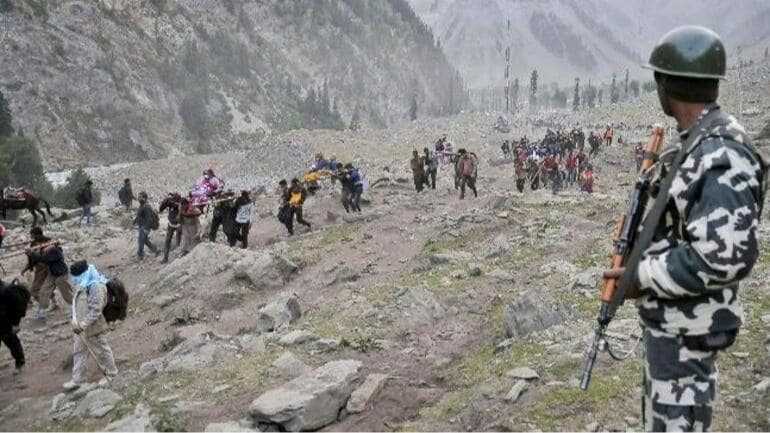
‘More than 52k pilgrims paid obeisance at the cave shrine till Jul 4’
The annual 43-day-long Amarnath Yatra-2022 is proceeding smoothly since it began on June 30 from the two base camps – the traditional 48-km-long Nunwan-Pahalgam route in south Kashmir's Anantnag district and the 14-km shorter Baltal route in Central Kashmir's Ganderbal district.
Till Monday, according to available UT government data, over 52,000 pilgrims have visited the holy cave shrine to pray before the naturally formed ice Shivlingam.
A video produced by Brighter Kashmir shows several pilgrims walking along the route with the help of long wooden sticks, or riding on ponies towards the shrine.
All of them have Radio Frequency Identification (RFID) tags around their necks, which has been made compulsory by the Shri Amarnath Shrine Board (SASB) to help locate a person/devotee.
Brighter Kashmir spoke to people travelling along the route to find out the benefits of the RFID tags.
A woman SASB official told BK: “Pilgrims can easily be tracked via the number on their respective cards. These RFID cards are linked with your Aadhaar card. So, in the event anybody diverts from the prescribed route, or goes missing, he or she can be tracked quickly. This is a very good initiative on the part of the UT administration. It is the first time we have introduced this.”
A pilgrim said: “This is a good initiative. There is no inconvenience or harassment by security personnel. It takes them about two minutes to locate anyone.”
A PC operator told BK: “These ID cards are very helpful to locate someone going astray. We can immediately contact the local police for assistance if they go missing.”
“The RFID tag is very useful as it is linked with the Aadhaar card and tells us whether a pilgrim is genuine or not,” another operator said.
It may be recalled that at the start of pilgrimage, shrine board CEO Nitishwar Kumar had asserted that pilgrim security is the board’s top priority and that the most important benefit of the RFID tag was to find out if there are any unauthorised persons taking part in the pilgrimage.
RFID tags can be procured from Srinagar or Jammu airports, besides railway stations. They are also available with authorised local vendors. The Amarnath Yatra will go on till August 12 and the government expects at least 600,000 pilgrims to take part in this year’s pilgrimage.
Security arrangements for the pilgrimage are being reviewed at regular intervals to prevent any untoward incident. This year’s yatra is taking place after a gap of three years. The Amarnath shrine is considered to be one of the holiest spots in India. The main cave is situated at a height of 12,756 feet from sea level and remains covered with snow for most of the year.
‘More than 52k pilgrims paid obeisance at the cave shrine till Jul 4’
The annual 43-day-long Amarnath Yatra-2022 is proceeding smoothly since it began on June 30 from the two base camps – the traditional 48-km-long Nunwan-Pahalgam route in south Kashmir's Anantnag district and the 14-km shorter Baltal route in Central Kashmir's Ganderbal district.
Till Monday, according to available UT government data, over 52,000 pilgrims have visited the holy cave shrine to pray before the naturally formed ice Shivlingam.
A video produced by Brighter Kashmir shows several pilgrims walking along the route with the help of long wooden sticks, or riding on ponies towards the shrine.
All of them have Radio Frequency Identification (RFID) tags around their necks, which has been made compulsory by the Shri Amarnath Shrine Board (SASB) to help locate a person/devotee.
Brighter Kashmir spoke to people travelling along the route to find out the benefits of the RFID tags.
A woman SASB official told BK: “Pilgrims can easily be tracked via the number on their respective cards. These RFID cards are linked with your Aadhaar card. So, in the event anybody diverts from the prescribed route, or goes missing, he or she can be tracked quickly. This is a very good initiative on the part of the UT administration. It is the first time we have introduced this.”
A pilgrim said: “This is a good initiative. There is no inconvenience or harassment by security personnel. It takes them about two minutes to locate anyone.”
A PC operator told BK: “These ID cards are very helpful to locate someone going astray. We can immediately contact the local police for assistance if they go missing.”
“The RFID tag is very useful as it is linked with the Aadhaar card and tells us whether a pilgrim is genuine or not,” another operator said.
It may be recalled that at the start of pilgrimage, shrine board CEO Nitishwar Kumar had asserted that pilgrim security is the board’s top priority and that the most important benefit of the RFID tag was to find out if there are any unauthorised persons taking part in the pilgrimage.
RFID tags can be procured from Srinagar or Jammu airports, besides railway stations. They are also available with authorised local vendors. The Amarnath Yatra will go on till August 12 and the government expects at least 600,000 pilgrims to take part in this year’s pilgrimage.
Security arrangements for the pilgrimage are being reviewed at regular intervals to prevent any untoward incident. This year’s yatra is taking place after a gap of three years. The Amarnath shrine is considered to be one of the holiest spots in India. The main cave is situated at a height of 12,756 feet from sea level and remains covered with snow for most of the year.
© Copyright 2023 brighterkashmir.com All Rights Reserved. Quantum Technologies